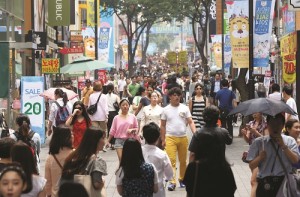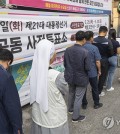- California Assembly OKs highest minimum wage in nation
- S. Korea unveils first graphic cigarette warnings
- US joins with South Korea, Japan in bid to deter North Korea
- LPGA golfer Chun In-gee finally back in action
- S. Korea won’t be top seed in final World Cup qualification round
- US men’s soccer misses 2nd straight Olympics
- US back on track in qualifying with 4-0 win over Guatemala
- High-intensity workout injuries spawn cottage industry
- CDC expands range of Zika mosquitoes into parts of Northeast
- Who knew? ‘The Walking Dead’ is helping families connect
No. of S. Korean cities with over 5 pct of foreign residents reaches 30
SEOUL (Yonhap) — The number of cities and towns where more than 5 percent of its residents are foreigners have reached 30 in the country, government data showed Wednesday.
In the district of Yeongdeungpo in southwestern Seoul, nearly two out of 10 residents are foreigners, with the figure reaching over 66,000. The number accounts for 17.5 percent of the total population in the district.
Following Yeongdeungpo, Geumcheon Ward and Guro Ward were listed as two other districts in Seoul with foreign residents accounting for more than 10 percent of the whole population. All three are located in the southwestern part of the city.
In Ansan, Gyeonggi Province, some 42 kilometers south of Seoul, where clusters of factories are located, some 83,000 foreigners, mostly from China and Southeast Asia reside, according to the data.
About 56,000 foreign residents live in Suwon, Gyeonggi Province, some 30 kilometers south of Seoul. In other cities in Gyeonggi Province surrounding the nation’s capital, such as Siheung and Hwaseong, the number also goes over 40,000.
In 54 cities, counties and districts, the number reached over 10,000.
There are three kinds of foreign residents in South Korea — those who live in South Korea for more than 90 days but do not have Korean nationality, naturalized citizens, and those who are the underage children of foreign parents or married foreign immigrants.
The number of foreigners living in South Korea reached 1.74 million as of Jan. 1, accounting for 3.4 percent of the total residents registered with authorities, according to the Ministry of Government Administration and Home Affairs.
Compared with 540,000 foreign residents recorded in 2006, the figure has tripled.
“In our society, they play a key role by providing workforce to small and medium-sized enterprises and easing the gender imbalance,” Lee In-jae, an official from the ministry said. “It’s time for us to invest in policies for immigrants and their children to better integrate into our society.”


















Pingback: Foreign Accountant | Apply - Accounting Jobs Online
Pingback: Foreign Accountant | ABC Accounting